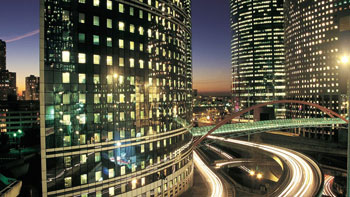Page 1 Page 2

WARNING: Plot spoilers below for Collateral
In daylight, the cities we inhabit take on a very different function and feel to that of nighttime. At sunrise, the city becomes a place of labour and socialization, of culture and community. The constant movement of raucous transportation and talkative commuters offers a distraction to the surroundings and an immersion into the frantic flow of the city. Our senses become numbed by the intense over-stimulation that the squeal of subway trains, the hum of tall buildings, the exhaust fumes of continuous traffic and the hustle that crowds of people provide. When we return to the relative quiet of our homes, we are left emotionally raw, wired and bruised, yet eager to return and face it again.
When the night-time descends and the workers, students, and commuters leave the city behind, another breed of inhabitants emerges into the darkness. People who were perhaps there all along during the daytime hours, but so blurred into the background noise so as to be invisible. The city at night is an altered state where the flashing and changing advertisement displays, which were are only glimpsed in the daylight, now buzz and shine their neon glow menacingly onto the street below.
In film, the night time metropolis is deemed to be malevolent and sinful, a place where nothing good could ever happen. In the films Collateral (2004), Cosmopolis (2012), and Drive (2011) the normal inhabitants of the city disappear to their homes and are replaced by sinister misfits and degenerates. The vibrant mood and fast pace of the city by day is traded at night for unhurried and deliberate menace and violence.
The city at night has held great appeal to filmmakers for decades. The use of the city as an ominous character within the film came to fruition in the seventies with films such as Taxi Driver (1977) and The Warriors (1979). In these two films the metropolis is a neon-lit cesspit where the threat of violence and paranoia lurks around every corner. The darkness reflects the internal struggle and conflicts of the characters, and this internal mood is projected externally to the cityscape. Moreover, capitalism itself has made the city an even more segregated environment. The monolithic glass skyscrapers, plush hotels, bars and restaurants that have risen up at alarming rates throughout the world reflect the glossy, flashing billboards that create an ever-changing and inconsistent landscape below. At night the wealthy and affluent population lock themselves within these glass towers, behind the bulletproof glass and many floors above street level. The young and successful fill the nightclubs and bars that muscular bouncer’s keep guard from undesirables. The streets are left to the underclass.
Collateral, directed by Michael Mann, defines the mechanisms of the working city. In the day time, the sun shines brightly, a sense of restless energy and positivity is apparent. People are in constant transit. However, when Jamie Fox’s taxi driver, Max, heads towards downtown LA as dusk creeps in, a dark, looming cloud hovers over the glimmering city, foretelling impending doom for Max and his passenger, a young female lawyer who gives Max her number as he drops her off downtown. That impending doom comes in the form of Vincent (a silver haired Tom Cruise), a merciless hit man making five consecutive assassinations over the course of the night. Max is reluctantly dragged into the murder spree when Vincent’s first hit does not go according to plan and the body of a lowlife criminal falls two stories from a shabby apartment block onto the top of Max’s cab. The next few hours are spent in transit as Max ferries Vincent from hit to hit, until Max loses his cool, tosses Vincent’s satchel containing his hit list over a bridge and crashes the cab just before the last hit. When Max realizes the last hit is the young lawyer he took downtown earlier, he sets out to save her life and repent for facilitating Vincent’s crimes. The Los Angeles that Vincent and Max encounter is a concrete-and-glass jungle, a neon-lit hell. The menacing red glow of smog hangs over the inner city, casting a deadly light over the inhabitants. From above, the city resembles an open wound. The streetlights and cars create an illusion of blood pumping through veins. It’s obvious that Vincent would choose to make his hits at night, not only to cover his own crimes, but also because the lowlifes and informers he’s contracted to kill only come out at night, along with the other degenerates of the city. As the night progresses, Max attempts to disrupt Vincent’s work and eventually stands up to Vincent as the daytime arrives. They face-off, with Vincent dying from a bullet wound on the Los Angeles subway, left to ride the train towards the commuters who will soon be boarding.
Page 1 Page 2
Pages: 1 2

